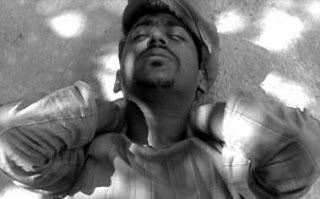Salaam Cinema
This write-up is in response to a blog written by my beloved friend, creative partner and critic, Somaasri (Soma),
Whenever my media team (Me, Soma and Nithya) is in canteen, it’s not just the coffee that is hot. Being a film enthusiastic lot, the atmosphere naturally gets heated up by cinema and just cinema.
Yesterday wasn’t different as she mentioned in her blog. Everything started with my remarks on the film “Salaam Cinema”, by celebrated Irani filmmaker Mohsen Makhmalbaf. True to my inclination towards experimental filmmaking, I was excited about the concept of this documentary film, which the filmmaker’s tribute to the one hundredth anniversary of cinema.
The director holds a casting call for 100 actors to appear in his next film. 5000 people show up, some desperate, some bewildered, and some self-absorbed. Dozens of men and women stand in front of the camera and explain their reasons for coming. They all express a burning, sometimes desperate, desire to work in film. One young man has traveled hundreds of miles pretending to be a blind man because he thinks that will give him an edge. One young woman wants to become a movie star so she can travel to film festivals abroad and see her boyfriend, who has emigrated. Another young man thinks he looks like Paul Newman…etc
Finally, when the director explains to the auditioners that he or she has just played his or her part in the film, each is amazed, uncomprehending. They have very different conceptions of what a film and film-acting should be like. But Makhmalbaf explains at one point, "If cinema reflects social life, then it is for everyone."
Now that’s a quick review of “Salaam Cinema”. But topic of discussion was the objective of filmmaking. Soma was so adamant that every film should convey the message to each and every viewer ( A, B and C class audience as called in India). I was defending her statement. In my view every filmmaker need not think that he should reach everyone. On the objective of filmmaking let’s classify filmmakers as Crappy filmmakers (Agenda: No clue why they are making film), Safe-side filmmakers (Agenda: Successful films for their survival with all safety measures for the success of film), Beautiful filmmakers (Agenda: A beautiful film imitating another beautiful film done in past or in another industry), Experimental filmmakers (Agenda: Break all rules and creates new dimensions for filmmaking inspiring other filmmakers)
Federico Fellini’s '8 ½', Mohsen Makhmalbaf’s ‘Salaam Cinema’, Alexander Sokurov’s ‘Russian Arc’, T. V Chandran’s ‘Danny’ etc, follows this pattern of experimental cinema. They are above all the other categories of filmmaking. In fact when others can be called filmmker, they are the innovators or scientists in cinema.
I’m not against the objectives or other filmmakers. I equally enjoy a crappy film and an experimental film. My simple answer to Soma is that all filmmakers need not think that they have to reach every single viewer. When the other categories of filmmakers target general public, experimental filmmaker reaches or inspires another filmmaker. Now that is his objective. Films need not be for everyone, they can be targeted at a sector of audience too…It is great if a filmmaker becomes the subject of study for another filmmaker.
Sometimes I feel that learning filmmaking is killing the innocence in me to enjoy a crappy film. But at the same time I’m proud that the knowledge of filmmaking is giving some kind of social responsibility. Filmmaking is a mission as well as a passion above profession.
Finally, when the director explains to the auditioners that he or she has just played his or her part in the film, each is amazed, uncomprehending. They have very different conceptions of what a film and film-acting should be like. But Makhmalbaf explains at one point, "If cinema reflects social life, then it is for everyone."
Now that’s a quick review of “Salaam Cinema”. But topic of discussion was the objective of filmmaking. Soma was so adamant that every film should convey the message to each and every viewer ( A, B and C class audience as called in India). I was defending her statement. In my view every filmmaker need not think that he should reach everyone. On the objective of filmmaking let’s classify filmmakers as Crappy filmmakers (Agenda: No clue why they are making film), Safe-side filmmakers (Agenda: Successful films for their survival with all safety measures for the success of film), Beautiful filmmakers (Agenda: A beautiful film imitating another beautiful film done in past or in another industry), Experimental filmmakers (Agenda: Break all rules and creates new dimensions for filmmaking inspiring other filmmakers)
Federico Fellini’s '8 ½', Mohsen Makhmalbaf’s ‘Salaam Cinema’, Alexander Sokurov’s ‘Russian Arc’, T. V Chandran’s ‘Danny’ etc, follows this pattern of experimental cinema. They are above all the other categories of filmmaking. In fact when others can be called filmmker, they are the innovators or scientists in cinema.
I’m not against the objectives or other filmmakers. I equally enjoy a crappy film and an experimental film. My simple answer to Soma is that all filmmakers need not think that they have to reach every single viewer. When the other categories of filmmakers target general public, experimental filmmaker reaches or inspires another filmmaker. Now that is his objective. Films need not be for everyone, they can be targeted at a sector of audience too…It is great if a filmmaker becomes the subject of study for another filmmaker.
Sometimes I feel that learning filmmaking is killing the innocence in me to enjoy a crappy film. But at the same time I’m proud that the knowledge of filmmaking is giving some kind of social responsibility. Filmmaking is a mission as well as a passion above profession.



